Asbestos inspections are crucial for keeping your home safe from harmful materials. You'll need a certified professional to conduct a thorough visual inspection and collect samples. This is especially important before any renovation or demolition work. Inspections aim to identify asbestos-containing materials (ACMs) and assess their condition. Regular monitoring and immediate action are necessary if ACMs are found. Understanding the legal requirements and health risks associated with asbestos exposure is critical for homeowners. By taking these steps, you guarantee a safer living environment. Exploring further details can help you better prepare for an asbestos inspection and its implications.
What Is an Asbestos Inspection?
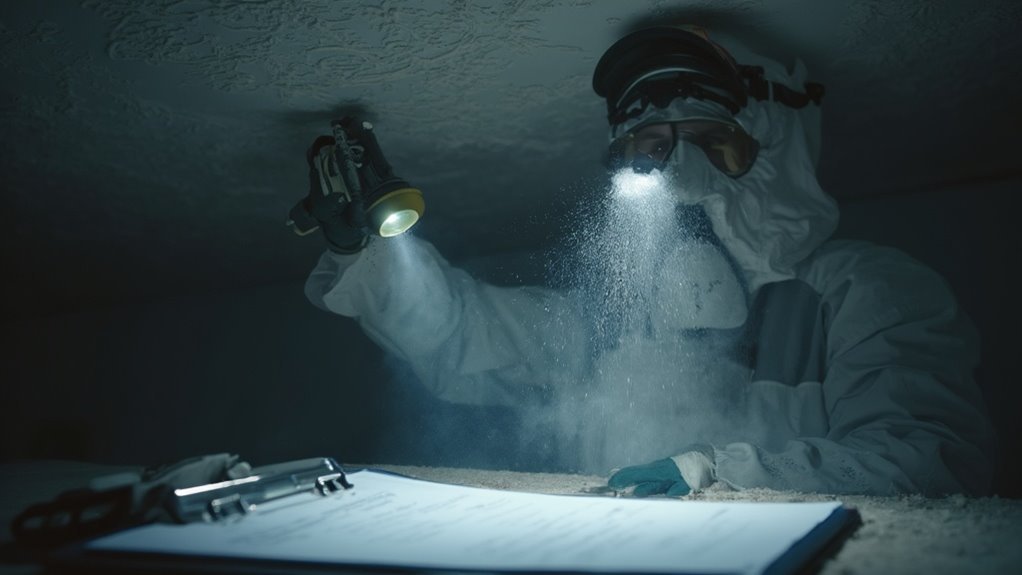
An asbestos inspection is a critical process designed to identify and assess asbestos-containing materials (ACM) within a building. This inspection is essential to comply with asbestos regulations, which have evolved substantially because of the serious health risks associated with asbestos exposure, rooted in its history as a commonly used building material.
The inspection process typically begins with a visual examination, lasting 2-3 hours for homes and longer for commercial properties. Inspectors focus on high-risk areas like insulation, roofing, and flooring, particularly in older structures built between the 1930s and 1950s, where ACM is more likely found. In some cases, sampling and laboratory analysis are necessary to confirm the presence of asbestos. Asbestos inspections are required before renovation or demolition activities to ensure safety.
Documentation of findings is important, encompassing the condition of the materials and any signs of damage. This information informs future actions, including the development of Operations and Maintenance (O&M) plans. By conducting an asbestos inspection, you're not only protecting yourself and others from potential exposure but also fulfilling legal responsibilities tied to asbestos regulations, safeguarding a safer environment in your home or facility.
When Is an Inspection Required?
Asbestos inspections are crucial in various scenarios, especially when it comes to building demolition, renovation projects, routine maintenance, and emergency situations. If you're planning a demolition, an inspection is mandatory, regardless of the building's age. This inspection must be conducted by a Certified Asbestos Consultant (CAC) and includes a thorough site survey and material sampling. Compliance with regulations like Rule 1403 and 40 CFR Part 763 is non-negotiable.
For renovation projects, if you're disturbing potential asbestos-containing materials, an inspection is required as well. It's essential to sample and analyze any materials to guarantee safety. Regular inspections may be necessary for certain non-residential properties, particularly educational facilities under the Asbestos Hazard Emergency Response Act (AHERA).
In emergency situations, such as structural damage or fire, you'll need to follow specific procedures for cleanup. A licensed Asbestos Abatement Contractor must handle this, guaranteeing compliance with stringent guidelines. Overall, understanding the historical usage of asbestos in your property can help underscore the importance of these inspections for regulatory compliance and safety.
Conducting an Asbestos Inspection
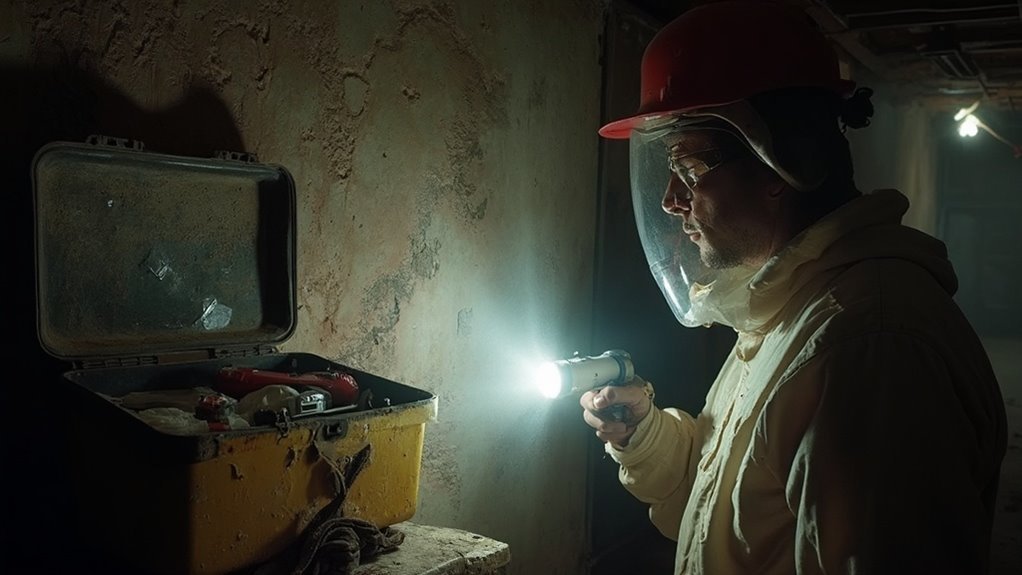
When conducting an asbestos inspection, you'll start with thorough preparation steps to guarantee a thorough assessment. You'll then employ precise sampling techniques to collect materials for analysis. Finally, understanding how to analyze results and report your findings is vital for effective risk management.
Inspection Preparation Steps
Preparing for an asbestos inspection involves several critical steps to guarantee the process is thorough and safe. First, you'll need to conduct a historical review of the building's records and plans to pinpoint areas where asbestos may be present. Hiring certified inspectors guarantees adherence to inspection protocols and regulatory compliance.
Here's a checklist to help you prepare effectively:
| Preparation Step | Action Required |
|---|---|
| Clear the Area | Remove personal items and obstacles |
| Seal Off Areas | Prevent fiber spread during inspection |
| Turn Off HVAC Systems | Stop air circulation |
| Provide Access | Facilitate easy entry to all spaces |
| Follow Safety Precautions | Adhere to containment recommendations |
During the visual inspection, assess accessible areas for signs of asbestos-containing materials (ACMs) like insulation or floor tiles. Document the location and condition of these materials meticulously. This proactive engagement reduces risks associated with asbestos exposure and guarantees a smooth inspection process. By following these steps, you'll create a safer environment for everyone involved.
Sampling Techniques Explained
After ensuring a thorough inspection preparation, the next phase involves employing effective sampling techniques to accurately assess potential asbestos presence. Start with a detailed visual inspection to identify suspect materials. Once identified, bulk sampling is critical; collect representative samples while minimizing disturbance to prevent cross contamination. Adhering to field protocols is necessary for regulatory compliance, so always wear protective clothing and properly fitted respirators.
Different materials require specific sampling strategies. For example, roofing materials over 450 m² need more samples, while friability testing helps determine the sampling needs of various materials. It's important to sample all layers, down to the sheathing or pipe, and investigate hidden spaces to guarantee a thorough assessment.
When collecting air samples, use methods like NIOSH for PCM and TEM to quantify asbestos concentrations accurately. Remember, minimizing filter contamination is imperative for precise analysis. Finally, keeping track of spatial and temporal trends in asbestos concentrations can improve your understanding of the environment you're dealing with. By following these techniques, you can effectively gauge the presence of asbestos in your home, guaranteeing a safer living space.
Analyzing Results and Reporting
Analyzing asbestos inspection results is crucial for ensuring the safety of your home. You'll need to focus on report interpretation to understand the implications of the findings accurately. The detailed report will detail the location, condition, and type of asbestos-containing materials (ACMs).
Here's a quick breakdown of what to expect in your report:
| Aspect | Details |
|---|---|
| Sampling Analysis | Results from laboratory analysis identifying ACMs. |
| Risk Assessment | Evaluation of the severity and management actions needed. |
| Recommendations | Suggested measures, such as encapsulation or removal. |
Identifying Asbestos in Your Home
Identifying asbestos in your home is vital for ensuring safety, especially if your residence was built before the 1980s, when asbestos was commonly used in various building materials. You should start by inspecting common asbestos sources, including attic insulation, pipe insulation, and duct insulation. Moreover, check for vinyl asbestos tiles or older linoleum flooring, as these often contain hidden dangers.
Pay attention to visual clues like the age of your home and any textured ceilings, which may suggest the presence of asbestos. For instance, popcorn ceilings and certain roofing materials, such as shingles and siding, might also be culprits. Dimpling on surfaces can indicate asbestos in materials like pipe insulation.
While you can look for these signs yourself, professional testing by a certified asbestos expert is the most reliable way to confirm its presence. They'll conduct laboratory analysis on collected samples and provide detailed inspection reports. Regular inspections and maintenance of potentially hazardous materials are critical to prevent deterioration. Remember, identifying asbestos is the first step in safeguarding your health and home, so don't hesitate to seek expert assistance when needed.
Handling Asbestos Safely
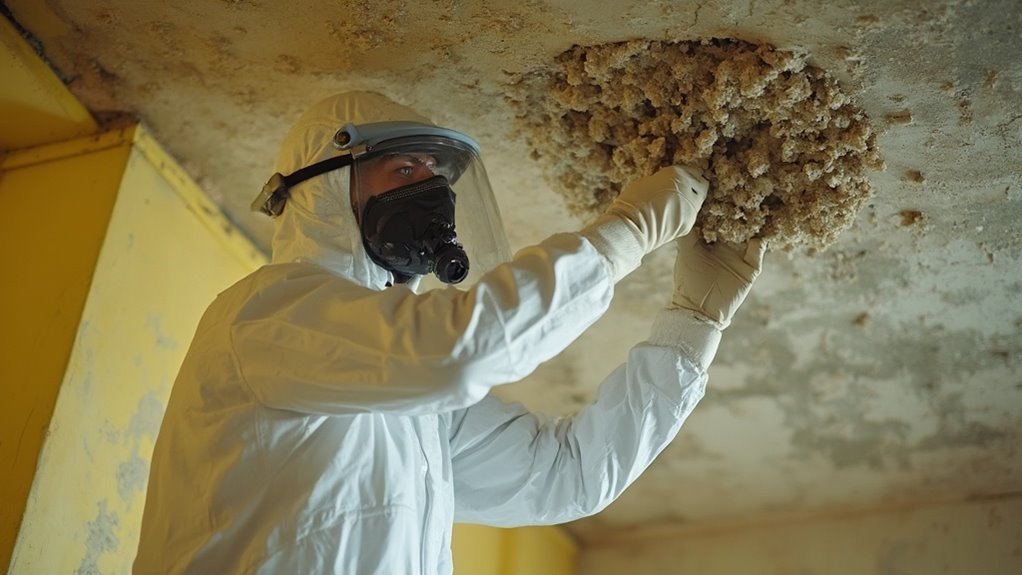
Handling asbestos safely requires a strategic approach to containment, removal, and ongoing monitoring. You'll need to implement effective containment strategies to prevent fiber release, use safe removal practices to minimize exposure, and establish regular monitoring procedures to guarantee the environment remains safe. By following these guidelines, you can substantially reduce the risks associated with asbestos in your home.
Asbestos Containment Strategies
When managing asbestos-containing materials (ACMs), a thorough containment strategy is vital for guaranteeing both safety and compliance. Effective containment protocols minimize the risk of fiber release during handling. Here are key strategies you should implement:
- Conduct Inspections: Identify and assess the condition of ACMs thoroughly.
- Design Containment Areas: Isolate ACMs with polyethylene sheeting and duct tape to prevent damage.
- Guarantee Adequate Ventilation: Use ventilation systems to reduce airborne asbestos fibers in work areas.
- Train Workers: Hold safety briefings to familiarize everyone with emergency procedures.
- Implement Air Monitoring: Regularly check air quality to guarantee fiber levels remain safe.
These strategies not only protect workers but additionally safeguard your home environment. Always remember, your goal is to prevent asbestos exposure by isolating and controlling the materials effectively. By following these steps, you can guarantee that your asbestos management practices are both safe and compliant with regulations. Prioritizing containment will substantially reduce the risks associated with handling asbestos, making your project safer for everyone involved.
Safe Removal Practices
After establishing effective containment strategies for asbestos-containing materials, the next step involves safe removal practices, which are critical for minimizing health risks. You must prepare the removal area by sealing it off with polyethylene sheeting and duct tape, creating a controlled environment. Implement engineering controls like negative air pressure units and HEPA filtration systems to guarantee fibre mitigation throughout the process.
Providing Personal Protective Equipment (PPE) is crucial. Guarantee workers wear NIOSH-approved respirators, coveralls, gloves, and eye protection. Establish clean and dirty zones with decontamination procedures to prevent cross-contamination. Monitor air quality continuously to maintain safe conditions.
When removing asbestos, employ wet removal methods to saturate materials and prevent airborne fibres. Conduct controlled dismantling to minimize fibre release, and avoid dry cleanup methods that can disturb harmful particles. After removal, clean the area thoroughly using wet methods or HEPA vacuums.
Finally, double-bag waste securely and label it appropriately. By following these safe removal practices and considering asbestos encapsulation techniques, you'll substantially reduce health risks associated with asbestos exposure, guaranteeing a safer environment for everyone involved.
Regular Monitoring Procedures
Regular monitoring procedures are essential for ensuring the ongoing safety of environments containing asbestos-containing materials (ACM). You need to implement both visual inspections and air sampling strategies to effectively manage ACM surveillance. Here are key elements to include in your monitoring plan:
- Conduct regular visual reinspections of ACM to detect damage.
- Use trained personnel for surveillance checks every six months in school buildings.
- Maintain visual records, like photos or videos, to track ACM conditions over time.
- Supplement inspections with air monitoring to catch potential fiber release.
- Design a proper air sampling strategy with a knowledgeable expert for early warnings.
Safety Precautions to Consider
To guarantee a safe environment during asbestos inspections, it's essential to implement thorough safety precautions. Start by isolating the inspection area; use plastic sheeting to seal it off and prevent asbestos fibers from spreading. Shut down ventilation systems to avoid contamination of the air. Make sure you use proper equipment for sample collection and transportation, and always wear disposable protective clothing along with NIOSH-approved respirators.
During the inspection, conduct a visual evaluation to identify high-risk areas, like insulation and flooring materials. Avoid disturbing asbestos-containing materials unless absolutely necessary. Employ wet methods for cleaning to minimize the release of fibers into the air.
After the inspection, follow strict post-inspection safety procedures. Perform thorough decontamination, use HEPA filter vacuums for cleanup, and guarantee proper disposal of personal protective equipment. Conduct air quality tests to assess any environmental impact caused by the inspection. Implementing these emergency protocols will not only help protect you but also guarantee a safer environment for everyone in the vicinity. Remember, hiring certified asbestos professionals is essential for effective inspections and to avoid the risks associated with DIY methods.
Legal Considerations for Homeowners
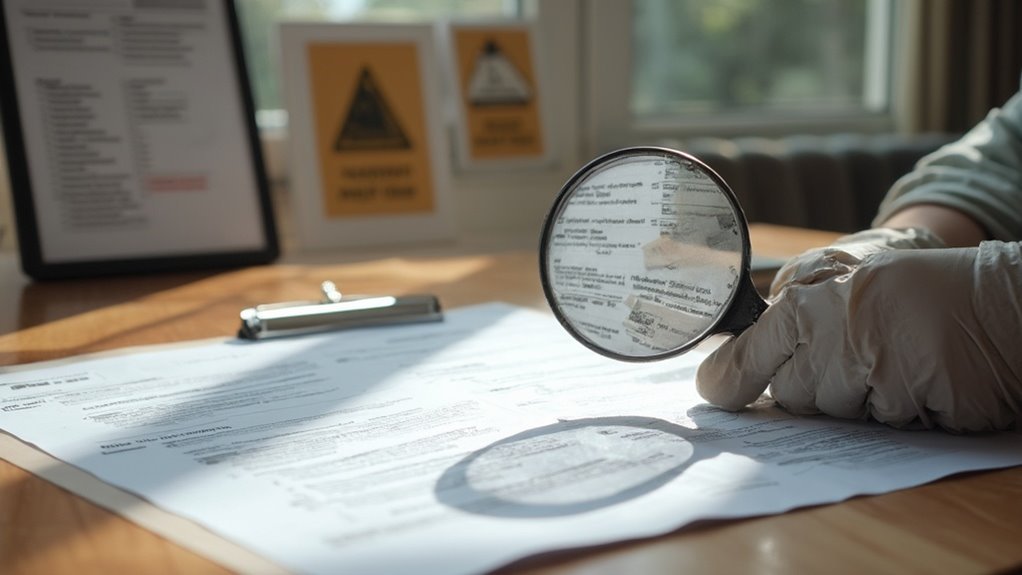
As you navigate the complexities of asbestos inspections, it's important to understand the legal considerations that come into play for homeowners. Failing to comply with disclosure obligations can lead to severe legal liabilities. Here are key points to keep in mind:
- Mandatory Transparency: You must disclose any known asbestos presence when selling your home.
- Inspection Reports: Share results of asbestos inspections with potential buyers to maintain transparency.
- Proactive Inspections: Conducting inspections before listing your property can prevent disputes and demonstrate responsibility.
- Legal Obligations: In Canada, you're legally required to disclose hazards, including asbestos, during the sale process.
- Financial Penalties: Non-compliance can result in fines or costly legal disputes if asbestos is found after the sale.
Importance of Professional Assistance
Professional assistance in asbestos inspections is vital for guaranteeing both safety and compliance. Trained inspectors possess the expertise to identify asbestos-containing materials (ACMs) that may not be visible to the untrained eye. This professional insight lowers the risk of exposure and improves safety during inspections. They provide detailed reports outlining the location and extent of asbestos, which is critical for guiding effective removal efforts.
Moreover, hiring professionals offers liability protection. Many inspectors carry professional liability insurance, which protects you against potential errors in judgment during the inspection process. This insurance coverage is particularly important in maintaining your property's value and minimizing environmental liabilities.
Qualified inspectors use specialized equipment and follow strict safety protocols, including area isolation and personal protective equipment, to prevent the release of dangerous fibers. Their meticulous approach guarantees the careful handling of samples and proper decontamination afterward, substantially reducing risks associated with asbestos.
Health Risks of Asbestos Exposure
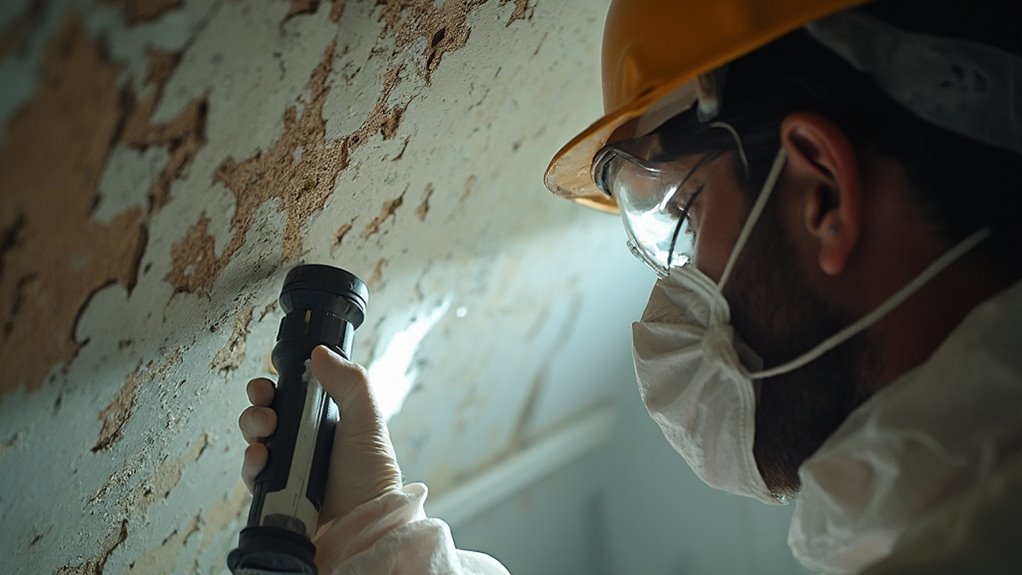
Even minimal exposure to asbestos can pose serious health risks, making awareness of these dangers vital for homeowners. The health effects of asbestos exposure are severe and can manifest even after brief encounters. Understanding these risks can help you make well-informed decisions regarding your home.
Consider these potential health issues linked to asbestos exposure:
- Mesothelioma, a rare but aggressive cancer
- Lung cancer, substantially increased in smokers exposed to asbestos
- Asbestosis, leading to chronic respiratory problems
- Pleural plaques and thickening, indicating underlying damage
- Secondhand exposure risks from contaminated clothing
Asbestos regulations exist to protect the public, but awareness is fundamental. Even short-term exposure can increase your risk of developing serious conditions later in life. The combination of exposure duration, type of asbestos, and individual factors like genetics plays a critical role in determining your susceptibility.
Frequently Asked Questions
How Much Does an Asbestos Inspection Typically Cost?
An asbestos inspection typically costs between $200 and $800, influenced by inspection fees and location costs. Urban areas usually charge more, while property size and project complexity additionally affect the final price.
Can I Conduct an Asbestos Inspection Myself?
Conducting an asbestos inspection yourself poses significant DIY risks, including inaccurate results and health hazards. Moreover, there are legal implications for improper handling, emphasizing the importance of hiring trained professionals for accurate and safe assessments.
What Should I Do if Asbestos Is Found?
If asbestos is found, prioritize safety. Follow containment methods, adhere to disposal regulations, and implement abatement procedures. Engage professionals for removal and the decontamination process, ensuring compliance with safety protocols to protect yourself and others.
How Long Does an Asbestos Inspection Take?
The inspection duration varies based on building size and site access requirements. Larger structures need multiple days, while limited access may necessitate return visits, potentially extending the overall time needed for a thorough assessment.
Are There Any Symptoms of Asbestos Exposure?
If you've been exposed to asbestos, you might experience respiratory issues like persistent cough, shortness of breath, or chest pain. These symptoms could indicate serious lung diseases, making it essential to seek medical advice promptly.
